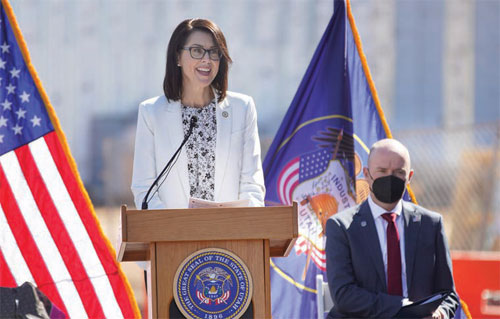By Brice Wallace
Utah companies looking to fill open job positions and people with employment gaps on their resumes are expected to benefit from a new state program designed to get those people back into the workforce.
Gov. Spencer Cox and Lt. Gov. Deidre Henderson recently announced a “returnship” program designed to provide more opportunities for people re-entering the workforce after an absence. The first step of the program calls for state agencies to boost returnship opportunities internally — Utah is the first state to offer it — and for private companies to do the same. Another program track provides short-term training opportunities at higher education institutions to help people learn new skills “designed to connect them with a rewarding career,” Henderson said.
Adults who have been out of the workforce for extended periods include full-time parents, members of the military and their spouses, caregivers, professionals and retirees who can get current experience, skills, training and mentoring needed to get back to work, she said.
“Unlike internships, which are designed primarily for young people at the beginning of their careers, the goal of a returnship program is to help experienced adults reenter the workforce without starting at the bottom of the career ladder,” she said.
“Diversity and life experience are valuable to us and should be relevant to pay and opportunity in the workplace. The returnship program will help us reach those who haven’t been participating in the job market for one reason or another.”
Many Utah companies have unfilled job positions, and the initiative “will help provide an innovative way for employers to find solutions to their workforce needs,” Henderson said.
Cox said the initiative is one of several designed to address Utah historically lagging behind the rest of the country when it comes to women’s involvement in the workplace. His own wife, Abby Cox, had talked about returning to the workforce after taking 20 years to raise their family, the governor said.
“She just said, ‘It’s almost impossible because I have this huge gap.’ Every employer who would look at that would say, ‘Well, I noticed you haven’t been working for 20 years,’ and you lose every time, right? They’re always going to take somebody who doesn’t have that gap, every time,” Spencer Cox said.
“What we’ve done today is, we get an opportunity to end that gap for especially women. Look, this is available to everyone, but we’re really talking about women here, right? Women who have been out of the workforce for a long time.”
Henderson noted that in 2019-20, Utah lost 12,000 jobs, with 8,000 being those held by women. “Our low unemployment numbers show that we have gained back most of the ground that we’ve lost, but we’ve also seen that occupations held predominately by women are recovering at a slower rate than occupations held mostly by men,” she said.
The returnship programs in state government and in the private sector may not necessarily mean that people returning to the workforce need more education, she said. For those who do, Utah’s Learn & Work program, which provides funds to Utah colleges and universities to provide training to qualified students, will get a $15 million infusion. In some programs, tuition will be paid for with state grants, and applications by people returning to the workforce will be prioritized, Henderson said.
The state’s returnship program was unveiled at Northrop Grumman’s Roy Innovation Center, where the company has been ramping up infrastructure and employment for its Ground Based Strategic Deterrent (GBSD) weapon system replacement for the Air Force’s aging LGM-30 Minuteman III intercontinental ballistic missile system.
As a way to get the workers it needs, Northrop Grumman is expanding its “iReturn” program, which it has in partnership with the Society of Women Engineers and iRelaunch. IReturn provides experienced professionals who have had a two-plus-year career break with a 12-week returnship to prepare for a full-time career in one of several fields at Northrop Grumman through training, professional development and networking opportunities.
The company has more than 6,700 employees at 14 Utah locations and gained more than 1,500 employees in 2020 in the state, but still has 800 job openings, according to Beth Pitts-Madonna, vice president of human resources for the company’s Space Systems sector. Thousands of jobs will be added over the next decade.
Partnerships and initiatives will allow the company to “fill the pipeline that we’re going to need not just today, but for the next several years to come,” said Greg Manuel, vice president and general manager of the Strategic Deterrent Systems division at Northrop Grumman’s Space Systems sector.
Through the GBSD modernization, “we will absolutely need critical skills for the next several years,” Manuel said. “Those critical skills are in engineering, software development, we need people to build things, we need accountants, we need business managers. We need every potential skilled employee that one can imagine to support a weapons system program such as the Ground Based Strategic Deterrent program.”








